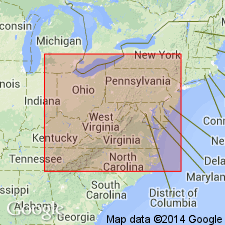
- Usage in publication:
-
- Burket Shale Member
- Modifications:
-
- Overview
- AAPG geologic province:
-
- Appalachian basin
Summary:
Burket Shale Member of the Harrell Shale correlates with basal part of the Genesee Formation of NY. In central PA between Williamsport, Lycoming Co., and Altoona, Blair Co., the black Burket Shale Member lies conformably upon the Tully Limestone. Unit has a few discoidal limestone nodules as much as 2 ft in diameter intercalated in the shale. Maximum thickness in outcrop is about 120 ft. Member thins to the south and grades into the upper part of the Millboro Shale in northern WV and its southeastern limit has not been established. It is lithologically similar to the Geneseo Shale Member of the Genesee Formation and occupies the same stratigraphic position above the Tully. However, a few conodonts from the basal Burket near Cumberland, MD, suggest that the Burket may be equivalent to the Genundewa Limestone Member or the West River Shale Member of the Genesee, which are Late Devonian, rather than Middle Devonian as is the Geneseo.
Source: GNU records (USGS DDS-6; Reston GNULEX).
For more information, please contact Nancy Stamm, Geologic Names Committee Secretary.
Asterisk (*) indicates published by U.S. Geological Survey authors.
"No current usage" (†) implies that a name has been abandoned or has fallen into disuse. Former usage and, if known, replacement name given in parentheses ( ).
Slash (/) indicates name conflicts with nomenclatural guidelines (CSN, 1933; ACSN, 1961, 1970; NACSN, 1983, 2005, 2021). May be explained within brackets ([ ]).

